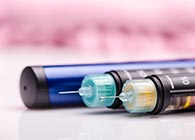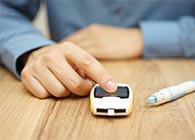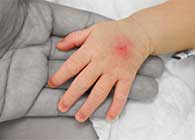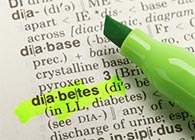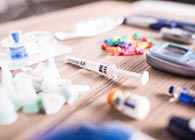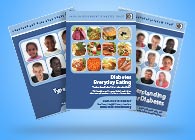Bellagio Report
The Bellagio Report
1996
by the International Team Residency supported by the Rockefeller Foundation, New York, USA
"The need to enable people requiring insulin to have an informed choice of insulin treatment"
The welfare of people with diabetes depends on their active participation in their care. To achieve this active participation the patient must have information about benefits, risks and alternatives concerning treatment and must have appropriate facilities available to make a free choice. New research has made possible an overall understanding concerning differences in warning symptoms of hypoglycaemia when using genetically produced human insulin and natural animal insulin.
The debate on these differences has continued since the introduction of treatment with human insulin and, unfortunately, very often the patients’ experiences have been classed as "only anecdotal" and of little value. Evidence supporting these experiences demonstrates neurophysiological differences during hypoglycaemia in human and animal insulins.
Research has already demonstrated that human insulin has no clinical advantage for patients and that it has a faster absorption and consequently a shorter duration of action, so accounting for the greater fluctuations in blood-glucose levels. However, it has been the general view that because of its exact similarity to endogenous insulin, human insulin should be the insulin of choice for all.
Based on the new understanding of the information from the neurophysiological studies which clearly support the reported adverse reactions to human insulin by many patients, we recommend:
- That this latest information be relayed to those living with insulin dependent diabetes. This will enable those experiencing impaired or reduced warning symptoms of hypoglycemia or reduced feelings of well-being and safety to re-examine their choice oh human or animal insulin. This choice will then be based on both scientific evidence and the reported experiences of patients;
- That this information be reported to Government Health Departments, WHO, IDF, Diabetes Associations, Physicians and all diabetes health care professionals throughout the world;
- That when insulin is needed, animal insulin should be considered as first choice treatment for all those where hypoglycaemia may be of special concern. This may include the following:
- Children
- The elderly
- Those reporting severe and/or frequent hypoglycaemia
- Those with severe cardiovascular disease or long term complications
- Those who do not have access to frequent blood-glucose monitoring, e.g. in developing countries.
- That animal insulin:
- remain available in all countries which presently have that facility
- is re-introduced into countries in which it is no longer available or in which it is no longer available through the normal prescribing mechanism;
- for insulin pens becomes available, again to provide equal choice for patients and physicians
- That in future greater recognition should be given to the value of patient experiences in relation to adverse drug reactions.
Rockefeller Study & Conference Center
I-22021 Bellagio (Como), Italy
April 8, 1996
Prof. Arthur Teuscher, MD (Switerland)
Dr. Pier Luigi Barbero, MD (Italy)
Nina Bollhalder Sureskumaran (Switerland)
Jenny Hirst, FBCO (UK)
Dr. Matthew Kiln, MB.BS/DRCOG (UK)
Scott King, Editor-in-Chief (USA)
Dr. Kristian Midthjell, MD (Norway)
Dr. Deo Mtasiwa, MD/PhD (Tanzania)
Dr. Shiva Murugasampillay, MB.BS/MSc (Zimbabwe, unable to attend)
Prof. Malina Petkova, MD (Bulgaria)
Scientific Information for the Bellagio Report, April 1996
"Human Insulin Hypoglycaemia Unawareness: Accumulated Evidence on the Phenomenon"
Introduction
A debate on the well-known topic of hypoglycaemia unawareness has been going on since the introduction of animal insulin 75 years ago. A few patients, mainly insulin-dependent, have suffered from insulin hypoglycaemia unawareness (abrupt severe hypoglycaemia without warning symptoms) over all these years. This debate has risen sharply since the first publication of an apparent sudden rise of this hypoglycaemia syndrome linked to human insulin in 1987 1,2, later confirmed by controlled studies with so called human (HI) vs porcine (PI) insulin from various diabetes centres. 3,4,5.
Many diabetes care professionals around the world do continuously observe differences between human and animal insulin in clinical practice: unawareness of hypoglycaemia symptoms, unstable diabetes control, increased severity of hypoglycaemic episodes without warning symptoms. Human insulin is still one possible explanation for the so called "dead in bed syndrome" (approximately 50 sudden unexplained deaths in young insulin-dependent diabetics, going to bed in apparently good health and later found dead in an undisturbed bed) 6,7,8. The full explanation still remains unanswered.
Since the introduction of human insulin of recombinant DNA origin in 1982 the official FDA (USA) labelling carries a warning 9. In 1991 the warning was highlighted by the FDA’s mandate imposing the use of bold print. "A few patients who experienced hypoglycaemic reactions after transfer from animal-source insulin to human insulin have reported that the early warning symptoms of hypoglycaemia were less pronounced or different from these experienced with their previous insulin."
Recent research has shown important new evidence in hypoglycaemia effects in the brain explaining the loss of awareness of hypoglycaemia in insulin requiring diabetic patients 10. It also provides another very important piece of the jigsaw puzzle in understanding the specific loss of hypoglycaemia awareness in a subset of human insulin consumers.
We are pleased to report that now there is also a logical neurophysiological and pharmacodynamic explanation for the phenomenon of "human insulin hypoglycaemia unawareness". We hope all health care professionals will be able to accept that these new findings show a mechanism to explain differences between these two species of insulin, and that these are significant for a substantial number of insulin users – "that the awareness of changes in central nervous stimulus processing (being stronger after PI than HI) may serve as a first subjective cue for an acute impending hypoglycaemia"11.
Relevant research demonstrating a mechanism for the difference in hypoglycaemic awareness between human and animal insulin (and practical information).
- Patients who have experienced difficulties with human insulin are mainly those who keep good or tight control 12 (observations).
- A recent study concludes that the uptake of glucose in the brain during hypoglycaemia, is a major mechanism for inducing hypoglycaemia unawareness, more so with tight than intermediate or poor control 10. Boyle 10 showed that in two patient groups with less well controlled diabetes with elevated blood glucose concentration (HbA1c 8.5 and 10.2%), the glucose uptake in the brain dropped during hypoglycaemia so sparking off the counter-regulatory hormones and producing early warning symptoms of the impending hypoglycaemia10. However, in patients with good or tight control (HbA1c 7.2%) and in patients who had experienced a recent "hypo", the intra-cerebral glucose did not drop during hypoglycaemia and the brain did not react to peripheral ongoing hypoglycaemia. This inappropriate response suggests that counter-regulatory hormones, like adrenalin, were lacking. The study was performed with human insulin.
- Another part of the explanation comes from the molecular differences between human and animal insulin. These show that animal insulin is more lipophilic than human insulin which is more hydrophilic 13,14, resulting in a faster cerebral accumulation of porcine insulin 15. One can therefore make the logical assumption that the intra-cerebral concentration is higher, thus reducing brain glucose during hypoglycaemia at an equivalent peripheral blood glucose level. A consequence of this will be a reduction or loss of awareness of hypoglycaemia with human insulin in some patients.
- Evidence to support this view comes from research, some of which has not been referenced frequently in the large reviews done on this subject. This research shows differences in neurophysiological 15,16 and higher sensory function between human and animal insulin 17. Auditory and visual responses, as well as auditory brain stem, responses were significantly weaker during the first 20 minutes of hypoglycaemia induced by human insulin, than with animal insulin 17. Kern et al. concluded that "… human and pork insulin induced hypoglycaemia differ in their actions". The differences in awareness of human and porcine insulin induced hypoglycaemia are very likely a consequence of differential processing signals within the nervous system.
- The above area of research demonstrates a mechanism which explains the differences in awareness of hypoglycaemia between human and animal insulin found in clinical studies 1,18,19,20,21,22,23,24.
- Many other studies showing a reduction in counter-regulatory hormone response in hypoglycaemia comparing human and animal insulin give further support to this explanation 25,26,27,28. Of particular importance are those studies demonstrating a greater adrenergic response with animal insulin in hypoglycaemia 29,30. This in effect is showing change from clearly recognised adrenergic to neuroglycopenic symptoms with primary or secondary human insulin treatment, which explains the experiences of patients.
- Heller and Cryer 31 found that one single episode of hypoglycaemia could trigger the loss of warning mechanism of hypoglycaemia and Mitrakou et al. 32 showed that hypoglycaemia itself can induce unawareness of hypoglycaemia and a decrease in the counter-regulatory hormones.
Note: Perfectionists may wish to see this fully logical theory tested out by a repeat of Boyle’s study using animal and human insulin in controlled settings. But there seems little point in subjecting more patients to experimental insulin hypoglycaemia when there are risks of consequent loss of awareness that inevitably follow it 33.
- More erratic blood glucose levels experienced by some patients when using human insulin can be explained by the faster absorption and shorter duration 34. An explanation of the other reported adverse cognitive brain effects of human insulin by family members and colleagues (depression, anxiety, other psychological events, aggressive tendencies, personality changes) is now necessary.
- Pharmacological studies clearly demonstrate that human insulin is absorbed faster than animal insulin, thus increasing the serum insulin concentration (up to significant differences) during the first hours after subcutaneous injections 35.
Although it is difficult for many of us to understand this, in two large collections of data held by the British Diabetic Association and the Insulin Dependent Diabetes Trust, cognitive symptoms like these were reported with remarkable consistency, either by patients or by their families, and the majority of these subjects (or carers) reported these difficulties resolving when the patient changed back to animal insulin, irrespective of the duration of treatment with human insulin (Posner T.R.: 3000 letters (384 analyzed) British Diabetic Association 1992. London)
Whether we fully understand these phenomena or not, we must listen to these opinions as patients have very little reason to lie and patient satisfaction, well-being and safety are key factors in diabetes care. Finally because the numbers are quite large, these reports and the ongoing research are very unlikely to have no foundation.
Fundamental practical design mistakes in many published scientific studies comparing human and animal insulin.
We need to examine how reliable scientific research is to account for the differences that seem to occur between insulin-research and every day use of insulin.
- Most commonly not recognising the effect study conditions have on changing the diabetic patients’ level of care they take with their control – this is often subconscious. This practical effect may be difficult for researchers to understand and it is probably only truly understood by those living with the condition.
- Patients entered into a trial are often not representative of the population with the disorder 36. Numbers of registered participants in research studies, the reasons for non participation and the real drop-out rates are either not published or under-reported 37,38.
- Unawareness studies involving self reporting of hypoglycaemia symptoms without recording of self measured blood glucose levels can only be of limited value as the patients may already have some degree of unawareness. Studies which include family members’ observations have more value but symptomless hypoglycaemic episodes can still be missed e.g. nocturnal hypoglycaemia which goes unnoticed 37,39,40.
- Studies which are obviously atypical of everyday life:
- Where the follow up visits to the diabetic clinic are every 2 to 4 weeks 37,38,40. In normal life visits are commonly every 26 to 52 weeks. Recording study events by questionnaire can increase the usual consultation time compared to routine visits.
- Where the number of home blood glucose tests are increased by up to 50% per week 40.
- Where the insulin species is randomly changed every 4, 6 or 12 weeks 38,41,42. In addition to this, IDDT’s analysis of case reports show that the adverse reactions to human insulin took on average 1.1 years to be recognised after starting to use human insulin 12,43.
- Where acute hypoglycaemia is induced by intravenous infusion, with the patient being maintained in a prone position anticipating hypoglycaemia and with an intravenous canula maintained in their arm, the symptoms of hypoglycaemia are then recorded under these conditions. Hypoglycaemia in everyday life is where the patient is preoccupied with work or pleasure and the "hypo" is neither gradual nor predictable 41,42.
- Perhaps the most significant error is the failure to realise that hypoglycaemia itself has been shown to produce loss of warnings for several days or longer, therefore hypoglycaemia occurring before the study (of which the patient may be unaware) or indeed slow hypoglycaemia induced by the study itself, may cause loss of warnings, regardless of insulin species 33.
- It is not wholly surprising that these studies show no difference between human and animal insulin. Common sense suggests that if patients complain of loss of awareness in everyday conditions 43 then a study must test for this under these conditions.
The last place one can expect a result that is valid for extrapolation to everyday life is from a slow glucose clamp technique procedure under laboratory conditions.
Conclusions
Human insulin is a useful insulin formulation and many people with diabetes can happily use it. However, a substantial minority of people with diabetes feel safer, have better hypoglycaemia warning symptoms with animal insulin and fewer abrupt hypoglycaemic episodes.
A transfer back to animal insulin brings relief in most instances from severe hypoglycaemic events due to loss of warning symptoms 44. Patients who have always been on human insulin may find advantages if they are allowed to change to animal insulin 45. At the Liverpool Symposium of human insulin and hypoglycaemia (1992) there was general agreement for carefully designed large field studies. Until such scientific evidence can be available, "the simple practical advice must be that patients who wish to use animal insulin should be able to have the insulin of their choice" 46. The balance of scientific data confirms that there are differences between human and animal insulin. Several show advantages with animal insulin in controlled studies also in the elderly despite an intact counter-regulatory response 47 and in numerous case histories. No studies show any clinical advantages of human compared to animal insulin.
Review of literature shows altered cognitive function and reduced autonomic nervous stimulation with human insulin. These observations are in agreement with the recent studies of brain glucose uptake in well-controlled diabetic patients 10 and offer an explanation for reduced awareness in some patients experiencing hypoglycaemic events from human insulin treatment. This explanation comes as a relief to many doctors and patients. Adding to this the many case reports from patients or their families who have experienced or witnessed practical problems with human insulin (Insulin Dependent Diabetes Trust, Draft Report. Feb. 1996) means that the case for saying that human insulin should not be the automatic first line choice insulin for most insulin-dependent or insulin-requiring diabetic patients is proven beyond reasonable doubt. (The International Team Residency, Rockefeller Foundation Center Bellagio, April 1996) This is in agreement with the rules and ethics of careful surveillance control as proposed by health governments and drug control agencies.
Suggestions (in addition to those already written in the Bellagio Report).
- Animal insulin should be used as the first line treatment in most newly diagnosed diabetic patients including the elderly. Exceptions may be made in those requiring pens i.e. poorly sighted, and some children, or those with previous insulin resistance.
- If patients on human insulin have unexplainable symptoms such as depression, aggressive behaviour, psychological changes, lethargy, muscle cramps, it may well be worth trying a change to animal insulin for at least 6 months.
- Human and animal insulin must remain available in all countries. Patients who are well- controlled on human insulin and do not suffer from unaccountable problems should not routinely be changed to animal insulin.
- Drug companies should produce animal insulin in pen injectors to give both doctors and patients an equal choice of insulin 46.
- Drug companies should again start producing a long acting animal insulin (e.g. Ultralente) which has a much longer tradition for smoother control compared to similar human products (e.g Ultratard HM) and would enable non-insulin-dependent diabetic patients to have one injection a day. A plea for animal Ultralente has been brought forward also in the United States48.
- All governments should assist all drug companies to ease re-licensing of animal insulin, especially the ultra-long acting insulins.
- In countries where animal insulin has been completely removed, government health departments should assist with the reintroduction of animal insulin as soon as possible.
Note: The Bellagio Report was circulated to ALL national and international diabetes associations and the departments of health in many countries.
References
- Teuscher A, Berger W. Hypoglycaemia unawareness in diabetics transferred from beef/porcine to human insulin. Lancet 1987; ii: 382-85.
- Wolff SP. Trying times for human insulin. Nature 1992; 356: 375-76.
- Egger M, Smith GD, Teuscher A. Risk of severe hypoglycaemia in insulin treated diabetic patients transferred to human insulin: a case control study. Br Med J 1991; 303: 617-21.
- Egger M, Smith GD, Teuscher A. Influence of human insulin on symptoms and awareness of hypoglycaemia: a randomised double-blind cross over trial. Br. Med. J. 303, 1991: 622-626.
- Egger M, Smith GD, Teuscher A. For debate: human insulin and unawareness of hypoglycaemia: need for a large randomised trial. Br Med J 1992; 305: 351-55.
- Tattersall RB, Gill GV. Unexplained deaths of type 1 diabetic patients. Diabetic Medicine 1991; 8: 49-58.
- Thodarson H, Sovik O. Dead in bed syndrome in young diabetic patients in Norway. Diabetic Medicine 1995; 12: 782-87.
- Sartor G, Dahlquist G. Short-term mortality in childhood onset insulin-dependent diabetes mellitus: a high frequency of unexpected deaths in bed. Diabetic Medicine 1995; 12: 607-11.
- Physicians desk reference PDR 36th edition 1982. Medical Economics. Montvale N.J.
- Boyle PJ, Kempers SF, O’Connor AM, Nagy RJ. Brain glucose uptake and unawareness of hypoglycaemia in patients with insulin-dependent diabetes mellitus. New Engl J Med 1995; 333: 1726-31.
- Kern W., Schlosser C, Kerner W., Pietrowsky R, Born J, Fehm HL. Evidence for effects of insulin on sensory processing in humans. Diabetes 1994; 43: 351-56.
- 450 case reports of adverse effects experienced on human insulin from patients and their partners. Insulin Dependent Diabetes Trust UK. Data still being collected. To be published in due course. Abstracts available.
- Markussen, J, Damguard U, Johansen NL, Jorgensen KM, Soressen E, Thiro L. Charakterisierung des aus Schweineinsulin präparierten Humaninsulin. Aktuel Endokrinal 1981; 1:104-114
- Chawdhury SA, Dodson EJ, Doson GG, Reynolds DC, Tolley SP, Blundell TL, Cleasby A, Pitty JE, Tickle IJ, Wood SP. The crystal of three non pancreatic human insulins. Diabetologia 1983; 25: 460-64.
- Kern W. Kerner W, Pietrowski R, Fehm HL, Born J. Effects of insulin and hypoglycaemia on the auditory brain stem response in humans. J Neurophysiol 1994; 72: 678-83.
- Kern W, Lieb K, Kerner W, Born J, Fehm HL. Differential effects of human and pork insulin-induced hypoglycaemia on neuronal functions in humans. Diabetes 1990; 39: 1091-98.
- Kern W, Born J, Kerner W, Fehm HL. Different effects of human and porcine insulin-hypoglycaemia induced abnormalities of brainstem sensory function Clin Physical Biochem 1990; 8: 122-27.
- Lingenfelser TH, Overkamp D, Renn W, Glück H, Maassen M, Eggstein M, Jakober B. Different awareness of hypoglycaemia induced by human or purified pork insulin in type 1 diabetic patients. Diab Res and Clin Pract 1991; 13: 29-36.
- Schlüter KJ, Petersen KG, Sontheimer J, Enzmann F, Kerp L. Different counter regulatory response to human insulin and purified pork insulin. Diabetes Care 1982; 5 (supple.2): 78-81.
- Poptis S, Karasiskos C, Enzmann F, Hatidakis D, Zoupa C, Souratzoghou A, Damontapoulos E, Moulopoulos S. Biologic activities of biosynthetic human insulin in healthy volunteers and insulin-dependent diabetic patients monitored by the artificial endocrine process. Diabetes Care 1981; 4:155-62.
- Jakober B, Lingenfelser T, Glück H, Maassen T, Overkamp D, Renn W, Eggstein M. Symptoms of hypoglycaemia – a comparison between porcine and human insulin. Klin Wochenschr 1990; 68: 447-53.
- Heine RJ, Von der Heydwsen EAP, Van der Heyden EA. Responses to human and porcine insulin in healthy subjects. Lancet 1989 (21.10.); 946-48.
- Meneilly GS, Milberg WP, Tuokko H. Differential effects of human and animal insulin on the responses to hypoglycaemia in elderly patients with NIDDM. Diabetes 1995; 44: 272-77.
- Berger W, Keller K, Honegger B, Jaeggi E. Warning symptoms of hypoglycaemia during treatment with human and porcine insulin in diabetes mellitus. Lancet 1989; i: 1041-1044.
- Owens DR, Vora JP, Trower B, Keller U, Luzio S, Turker A. Hormonal counter-regulatory responses to human (semi synthetic and re-combinant DNA) and porcine insulin induced hypoglycaemia. Diabetes Res 1988; 8: 1-8.
- Petersen KG, Schlüter KJ, Kerp L. Less pronounced changes in serum potassium and epinephrine during hypoglycaemia induced by human insulin (recombinant DNA). Diabetes Care 1982; 5:90-92.
- Schlüter KJ, Petersen KG, Enzmann F, Kerp L. Different potencies of biosynthetic human insulin and purified porcine insulin. Hormone Met Res 93.
- Rosak C, Althoff PH, Enzmann F. Schoffling K. Comparative studies on intermediary metabolism and hormonal counter-regulation following human insulin and purified pork insulin. Diabetes Care 1982; 5 (suppl.): 82-89.
- Clausen Sjöborn N, Lins PE, Adamson U, Theodorsson E. A comparative study on the hormonal responses to insulin-induced hypoglycaemia using semi-synthetic human insulin and pork insulin in patients with type 1 diabetes mellitus. Diabetic Med 1990; 7: 775-79.
- Fisher BM, Gray C. Beastall G, Frier BM. Responses to acute insulin-induced hypoglycaemia in diabetic patients. A comparison of short acting human and porcine insulins. Diab Res 1988; 8:1-8.
- Heller S, Cryer P. Reduced neuroendocrine and symptomatic responses to subsequent hypoglycaemia after one episode of hypoglycaemia in non-diabetic humans. Diabetes 1991; 40: 223-26.
- Mitrakou A et al. Reversibility of unawareness of hypoglycaemia in patients with insulinomas. New Eng J Med 1993; 329: 834-39.
- Hirst J, Hill J. Ethics and validity of hypoglycaemia unawareness studies (Letter). Lancet 1996; 347: 1343-44
- Heiman L, Richter B. Clinical pharmacology of human insulin. Diabetes Care 1993; 16 (suppl. 3): 90-100.
- Galloway JA, Root MA, Bergstrom R, Spradlin CT, Howey DC, Fineberg SE, Jackson RL: Clinical pharmacologic studies with human insulin (recombinant DNA). Diabetes Care 1982; 5 (suppl. 2): 13-22.
- Laupacis A, Wells G, Richardson S, Tugwell P. Users guides to the medical literature. JAMA 1994; 272: 234-37.
- Colagiuri S, Miller JJ, Petocz P. Double-blind crossover comparison of human and porcine insulins in patients reporting lack of hypoglycaemia awareness. Lancet 1992; 339: 1430-35.
- Patrick AC, Bodner CW, Tieszen KL, White MC, Williams G. Human insulin and awareness of acute hypoglycaemic symptoms in insulin-dependent diabetes. Lancet 1991; 338: 528-532.
- Mokan M, Mitrakou A, Venemon T. Ryan C, Korytkowski M, Cryer P, Gerich J. Hypoglycaemia unawareness in IDDM. Diabetes Care 1994; 17 (12): 1397-1403.
- Maran A, Lomas J, Archibald H, Macdonald IA, Gale EA, Amiel SA. Double-blind clinical and laboratory study of hypoglycaemia with human and porcine insulin in diabetic patients reporting hypoglycaemia unawareness after transferring to human insulin. Br Med J 1993; 306: 167-171.
- MacLeod K, Gold A, Frier BM. A Comparative study of responses to acute hypoglycaemia induced by human and porcine insulins in patients with type 1 diabetes. Diab Med 1996; 13 (4): 346-57.
- MacLeod KM, Gold AE, Frier BM: Frequency, severity and symptomatology of hypoglycaemia: a comparative trial of human and porcine insulins in type 1 diabetic patients. Diab Med 1995; 12 (2): 134-41.
- Kiln MR. Treatment of patients with human insulin. (Letter) Diabetologia Feb. 1996, 248.
- Teuscher A, Egger M. Human insulin hypoglycaemia unawareness. (Letter) Lancet 1989; May: 1072.
- Bradley C. Threader KA, Sourdon AJ. General well being satisfaction with treatment scales for use with people with insulin requiring diabetes. Report to WHO Regional Office for Europe, June 1992.
- Patrick AW, Williams G: The Liverpool Symposium on human insulin and hypoglycaemia. Diabetic Medicine 1992; 9: 579-80.
- Brierley EJ, Broughton DL, James OFW, Alberti KGMM: Reduced awareness of hypoglycaemia in the elderly despite an intact counter-regulatory response. QJ Med 1995; 88: 439-445.
- King SM. (Editorial) Diabetes Interview December 1994 (Editorial), Kings Publishing San Francisco, CA 94121, no. 29: 3.


